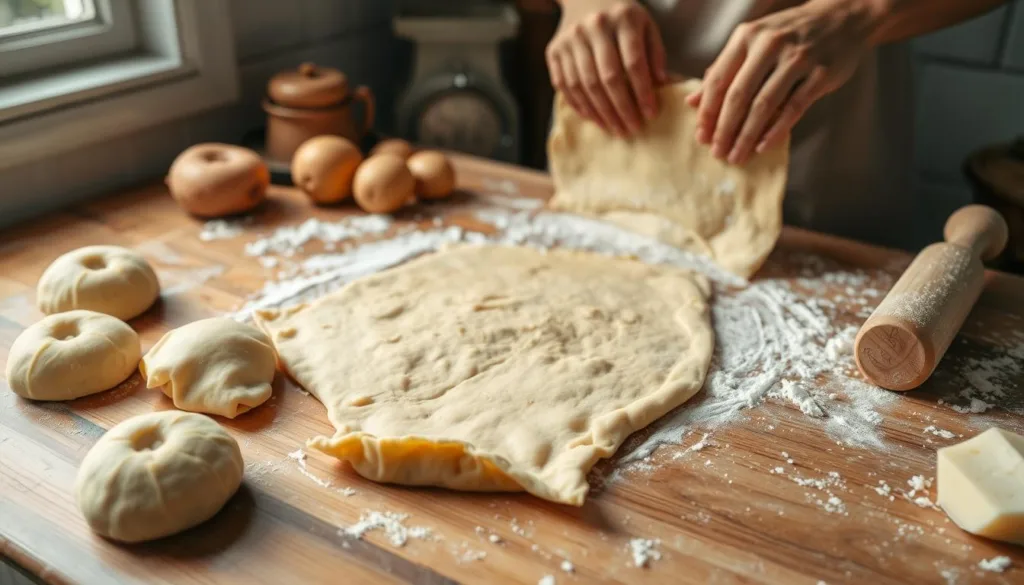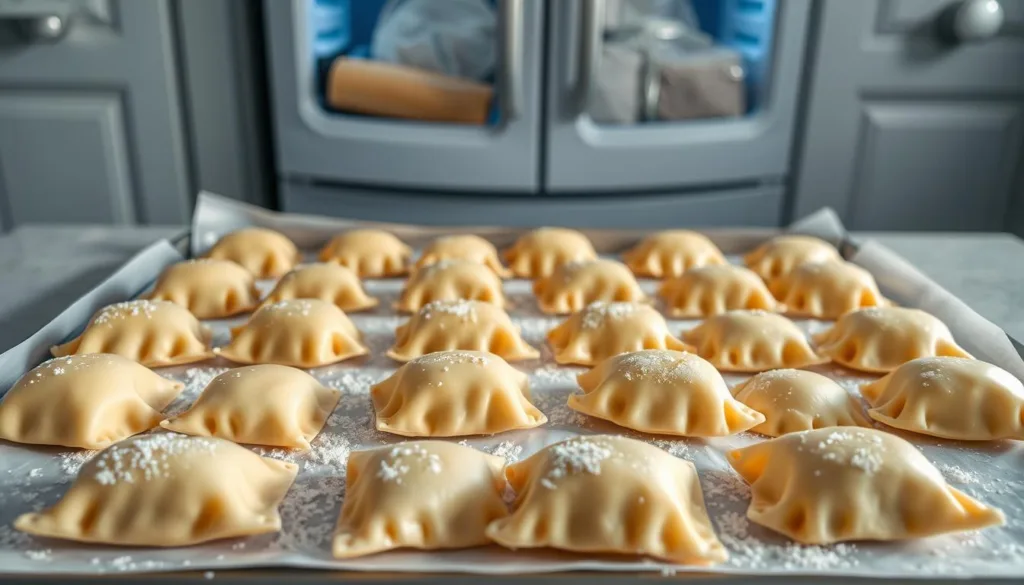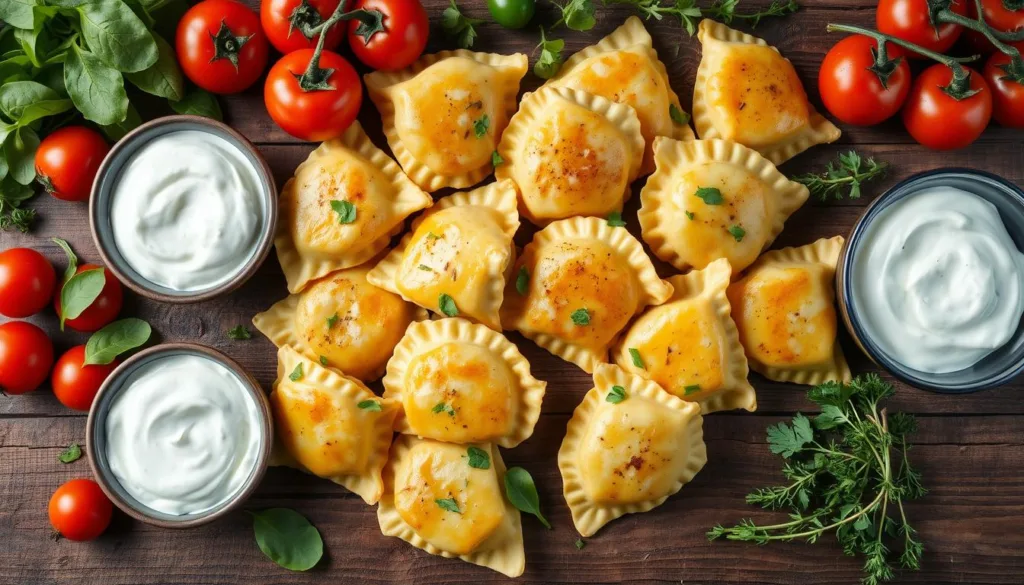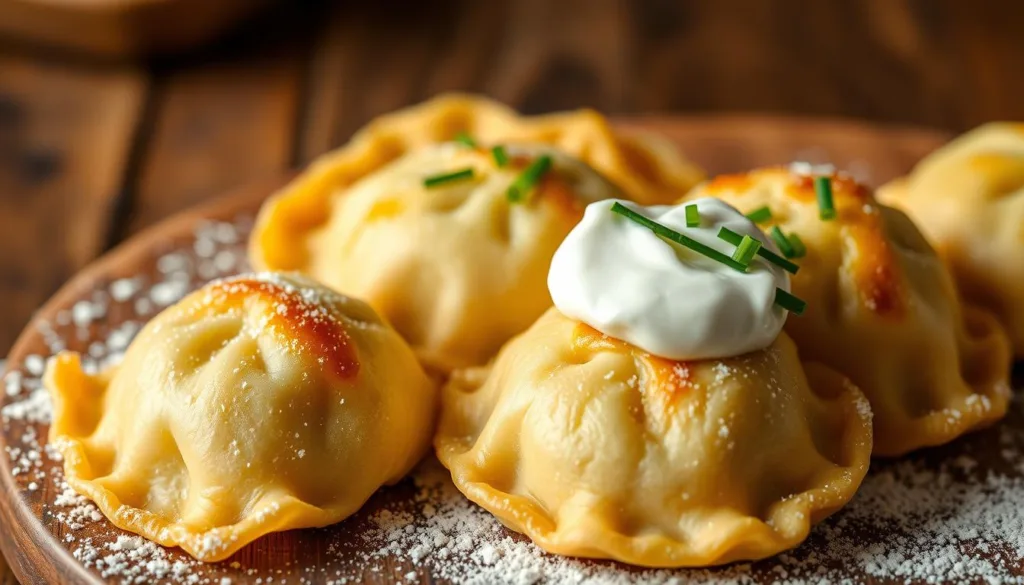Growing up, the smell of Polish dumplings in our kitchen brought back family memories. These potato cheddar pierogi are more than food. They connect us to our heritage, warmth, and love from past generations.
Pierogi are a comfort food that brings people together. They mix soft dough with a cheesy potato filling. This dish has won hearts around the world. It’s loved in both home kitchens and fancy restaurants, touching our souls.
If you’re looking to connect with your roots or just want a tasty meal, this guide is for you. It will show you how to make perfect potato cheddar pierogi. Get ready for a journey that turns simple ingredients into a masterpiece of Eastern European cuisine.
The Rich Heritage of Eastern European Dumplings
Eastern European cuisine is known for its rich tradition of savory dumplings. Potato dumplings are a key part of this tradition. These tasty treats have been passed down for centuries, filled with stories of family and tradition.
Origins in Central Europe
The story of pierogi starts in the 13th century. They quickly became a favorite in Eastern Europe. Poland’s first cookbook in 1682 officially recognized these delicious dumplings.
Cultural Significance in Regional Cuisine
Pierogi are more than just food. They are a big part of cultural celebrations and gatherings. They are often served at weddings, Christmas, and other big events. These dumplings show the importance of community and shared heritage.
- Historically considered peasant food
- Spread across social classes in Poland
- Became a national culinary symbol
Family Recipes Through Generations
Every family in Eastern Europe has its own pierogi recipe. These recipes are passed down through generations. Different regions have their own special fillings and ways of making them.
From Biłgoraj pierogi in Poland to Ukrainian varenyky, these dumplings show off local flavors and traditions.
“Pierogi are not just food; they are edible memories of our ancestors.”
These dumplings can be filled with potatoes and cheese, meat, or sauerkraut. They keep people connected to their culinary heritage. They have survived through many changes in culture.
Essential Ingredients for Perfect Pierogi Dough
Making delicious potato pierogies starts with the right ingredients. The key to great pierogi is using the best components. These ingredients turn simple items into a magical dish.
To make perfect pierogi dough, you need a few important things. Here’s what you need:
- Flour: Use a high-protein all-purpose flour for the best results
- Recommended quantity: 12.5 ounces (about 2 1/2 cups)
- Weight can vary between 120g-140g per US cup
- Liquid: Water and extra moisture
- Sour cream: 8 ounces (1 cup)
- Best water temperature: 80-90°C (176-194°F)
- Fat: Adds flavor and texture
- Vegetable oil: 2 tablespoons
- Unsalted butter can be used instead
Pro tip: Weigh your ingredients instead of measuring by volume to ensure consistent dough every time.
Perfect potato pierogies come from knowing how ingredients work together. Letting the dough rest makes it softer and more elastic. Whether you use a Kitchen Aid mixer or knead by hand, aim for 10 minutes of work to build the dough’s structure.
| Ingredient | Quantity | Purpose |
|---|---|---|
| All-Purpose Flour | 12.5 ounces | Structural base of dough |
| Kosher Salt | 1 teaspoon | Flavor enhancement |
| Large Egg | 1 | Binding and richness |
| Vegetable Oil | 2 tablespoons | Moisture and tenderness |
Making the perfect dough for stuffed pasta takes practice. Don’t worry if your first try isn’t perfect – even Polish grandmothers have secrets!
Crafting the Ultimate Potato Cheddar Filling
Making the perfect potato cheddar pierogi filling is all about choosing the right ingredients and how you prepare them. The key to delicious cheddar pierogies is their creamy potato and sharp cheese filling.
Selecting the Right Potatoes
Start with the right potatoes for your filling. Russet potatoes are best because they’re starchy and make a smooth, creamy base. Here’s how to prepare them:
- Peel and quarter the potatoes
- Boil until fork-tender, which takes about 15-20 minutes
- Drain thoroughly to prevent excess moisture
Cheese Selection and Preparation
The cheese is key to making cheddar pierogies unforgettable. Choose a high-quality sharp cheddar cheese. Cabot Seriously Sharp Cheddar is a great choice, adding intense flavor to your pierogies.
| Cheese Type | Quantity | Recommended Usage |
|---|---|---|
| Sharp Cheddar | 4 ounces per pound of potatoes | Provides rich, tangy flavor |
| Cottage Cheese | 1 1/2 cups | Adds creaminess |
| Cream Cheese | 8 ounces | Enhances texture |
Seasoning and Flavor Enhancement
Make your filling stand out with the right seasoning. A bit of kosher salt, sautéed onions, and herbs can make a big difference.
“The secret to amazing pierogi is in the details of your filling.” – Traditional Eastern European Cook
Each pierogi should have about 1 1/2 tablespoons of filling. With the right ingredients and preparation, your potato cheddar pierogies will be unforgettable.
Step-by-Step Guide to Making Pierogi Dough
Making the perfect dough is key for tasty polish dumplings. Your potato pierogies will only be as good as the dough they’re made from. Understanding the dough-making process is crucial for great pierogi.
To start making your pierogi dough, you’ll need these ingredients:
- 2 cups all-purpose flour
- ½ teaspoon salt
- 1 whole egg
- 1 egg yolk
- 1 tablespoon vegetable oil
Mixing these ingredients is where the magic begins. Start by mixing the dry ingredients. This creates a smooth base for your polish dumplings. Precision is key in pierogi dough preparation.
Pro tip: The secret to tender potato pierogies lies in proper dough handling and resting time.
After mixing, let your dough rest. It should rest for at least 15 minutes, but no more than 2 hours. This resting time helps the gluten settle, making the dough easier to roll and shape.
When rolling out your dough, aim for thin, even circles. A typical batch can yield 8-10 circles with a 3¼-inch diameter. Remember, practice makes perfect when crafting these traditional polish dumplings!
Potato Cheddar Pierogi: The Perfect Filling Recipe
Making delicious cheese pierogi begins with the right potato cheddar filling. This step turns simple ingredients into a tasty treat that will excite your taste buds.
Mashing and Seasoning Techniques
Start with russet potatoes for the best filling. Boil them for 20-30 minutes until soft. This makes a smooth, creamy base for your pierogi.
- Peel and quarter 4 russet potatoes
- Cook until completely tender
- Mash thoroughly to remove all lumps
- Season with kosher salt and pepper
Incorporating Cheese and Aromatics
The secret of potato cheddar pierogi is in the cheese mix. Add 2 cups of sharp cheddar cheese to your potatoes. For extra taste, mix in 1/2 teaspoon of onion powder and 2 tablespoons of butter.
| Ingredient | Quantity |
|---|---|
| Shredded Cheddar Cheese | 2 cups |
| Butter | 2 tablespoons |
| Onion Powder | 1/2 teaspoon |
Pro tip: Fold the cheese into the warm potatoes gently. This lets it melt and create a creamy filling that’s hard to resist.
The secret to great cheese pierogi is balancing flavors and achieving the perfect texture.
Proper Rolling and Cutting Techniques

Rolling and cutting pierogi dough is an art that needs precision and practice. Your dough should be rolled to a thickness that’s just right for these traditional polish dumplings. Aim for about 1/16 inch (2 mm) thickness. This is thin enough to be delicate but not so thin that it breaks easily.
Cutting techniques for pierogi are key to making uniform dumplings. You’ll need tools that help you make consistent rounds:
- Biscuit cutters
- Clean drinking glasses
- Specialized pierogi cutters
When cutting your dough, aim for rounds that are 3 to 4 inches in diameter. This size lets you fill each pierogi with about 1 tablespoon of tasty filling.
| Cutting Tool | Typical Diameter | Pierogi Yield |
|---|---|---|
| 2-inch Round Cutter | 2 inches | 3.5 dozen circles |
| 2 3/4-inch Cutter | 2.75 inches | 22-28 pierogi |
Pro tip: Dust your surface with flour to prevent sticking and ensure smooth rolling of your polish dumplings. Remember, practice makes perfect when creating these delightful stuffed pasta!
The Art of Filling and Sealing Pierogi
Making perfect potato dumplings needs precision and care. Learning to fill and seal them well can make your pierogi amazing.
To avoid drying out the dough, work quickly. Roll out the dough to less than 1/4 inch thick. Use about 1/3 of the dough at a time for easier handling.
Traditional Crimping Methods
The secret to great pierogi is in how you fill and seal them. Here are some key steps:
- Put a small amount of filling in the dough circle’s center
- Fold the dough to make a half-moon shape
- Press the edges together to seal
- Use a fork to crimp the edges for a traditional look
Troubleshooting Sealing Issues
Watch out for these common mistakes when filling your dumplings:
- Overfilling: Use only 1-2 teaspoons of filling per dumpling
- Make sure the edges are sealed well to avoid filling leakage
- Keep your work surface lightly floured to prevent sticking
“The secret to perfect pierogi is in the seal” – Traditional Eastern European Cooking Wisdom
Here’s a quick guide to help you improve your technique:
| Technique | Key Tips |
|---|---|
| Filling Placement | Center of dough circle |
| Sealing Method | Press edges firmly, crimp with fork |
| Dough Handling | Work with 1/3 of dough at a time |
| Filling Amount | 1-2 teaspoons per dumpling |
With practice, you’ll get better at making perfectly sealed dumplings. They’ll impress your family and friends.
Cooking Methods: Boiling and Pan-Frying
Learning how to cook potato pierogies is key to getting them just right. There are two main ways to cook them: boiling and pan-frying.
Boiling is the first step in making cheddar pierogies. Here’s what to do:
- Bring a large pot of salted water to a gentle boil
- Carefully drop pierogi into the water
- Cook for 2-3 minutes until they float to the surface
After boiling, you can pan-fry them for extra flavor. Pan-frying makes the pierogies crispy and golden.
Here’s how to pan-fry:
- Heat butter or oil in a skillet
- Place boiled pierogi in the pan
- Cook for about 2 minutes per side until golden brown
“The magic of pierogi lies in the perfect balance between soft, tender dough and a crispy, caramelized exterior.”
Here are some tips for cooking potato cheddar pierogies:
| Cooking Method | Time | Result |
|---|---|---|
| Boiling | 2-3 minutes | Soft, tender texture |
| Pan-Frying | 2 minutes per side | Crispy, golden-brown exterior |
Pro tip: Don’t overcrowd the pan when pan-frying to ensure each potato pierogi gets perfectly crisp!
Creating the Perfect Caramelized Onion Topping
Caramelized onions turn potato cheddar pierogi into a true culinary gem. These golden, sweet onions make the dish unforgettable.
Choosing the right onions is key for caramelized onions. Yellow onions are best because they’re sweet and flavorful. It takes about 30-40 minutes to caramelize them, so be patient and watch closely.
Selecting the Perfect Onions
- Choose medium-sized yellow onions
- Look for firm, blemish-free onions
- Aim for approximately 2¼ pounds of onions
Caramelization Techniques
To get perfect caramelized onions, follow these steps:
- Slice onions uniformly
- Use low, consistent heat
- Stir frequently to prevent burning
- Add a pinch of salt to enhance flavor
Your goal is to make deeply golden, melt-in-your-mouth onions. They should perfectly match the rich potato cheddar pierogi.
“Caramelized onions are the secret weapon of home cooks everywhere” – Chef Maria Kowalski
| Onion Type | Caramelization Time | Flavor Profile |
|---|---|---|
| Yellow Onions | 30-40 minutes | Sweet, Rich |
| White Onions | 25-35 minutes | Mild, Crisp |
| Red Onions | 35-45 minutes | Slightly Sharp |
Great caramelized onions need low, slow cooking and your full attention. The result is a delicious topping that makes your pierogi shine.
Traditional Serving Suggestions and Accompaniments
Polish dumplings, like cheese pierogi, have a long tradition of serving. The right accompaniments can make the meal even better.
- Sautéed onions
- Melted butter
- Crispy bacon
- Fresh chives or dill
- Sour cream
When serving cheese pierogi, the right amount is key. For a main meal, serve 8-10 dumplings per person. For a side, 3-6 pierogi are enough.
| Topping | Traditional Use |
|---|---|
| Skwarki (Fried Pork Fatback) | Primary savory topping in Poland |
| Sour Cream | Classic accompaniment |
| Chopped Herbs | Dill and chives for garnish |
Pro tip: Most Polish families prefer pierogi without extra sauces. This lets the natural flavors shine.
“The beauty of pierogi lies in their simplicity and the love put into their preparation.”
When making your cheese pierogi, the right toppings can make a big difference. Try different traditional toppings to find your favorite!
Make-Ahead and Storage Solutions
Preparing savory dumplings ahead of time can save you a lot of time. It ensures you always have a tasty meal ready. For potato dumplings like pierogi, keeping them fresh is important. Cooked pierogi can stay in the fridge for 3-5 days, making them a great make-ahead option.
Freezing is a great way to keep both cooked and uncooked potato dumplings for longer. Uncooked pierogi can be frozen for up to 3 months. This makes it easy to have a quick meal whenever you need one.
Storage Tips for Potato Dumplings
- Refrigerate cooked pierogi in an airtight container
- Separate layers with parchment paper to prevent sticking
- Freeze uncooked pierogi on a baking sheet before transferring to freezer bags
Here are some important tips for storing savory dumplings:
| Storage Method | Duration | Recommended Technique |
|---|---|---|
| Refrigerated Cooked Pierogi | 3-5 days | Store in sealed container |
| Frozen Uncooked Pierogi | Up to 3 months | Freeze on baking sheet, then store in freezer bags |
Pro tip: When reheating refrigerated or frozen potato dumplings, gently warm them in a skillet with a small amount of butter. This helps restore their crispy exterior and keeps their delicious texture.
“Proper storage is the secret to enjoying delicious pierogi anytime!” – Traditional Eastern European Cook
Tips for Freezing and Reheating
Keeping your homemade stuffed pasta fresh is key. Freezing potato cheddar pierogi helps them last longer. It’s perfect for when you’re in a hurry.
Proper Freezing Methods
Here’s how to freeze your pierogi right:
- Spread pierogi separately on a baking tray to prevent sticking
- Blanch pierogi for approximately 30 seconds in boiling water
- Allow pierogi to cool completely before freezing
- Use freezer-friendly bags labeled with the date of freezing

Your homemade potato cheddar pierogi can stay good for up to 3 months. But, don’t freeze them with raw meat or twaróg-based fillings.
Best Practices for Reheating
Reheating your frozen pasta needs some care:
- You can cook pierogi directly from frozen state
- Boil in salted water, adding half a glass of cold water after they float
- Pan-fry for 3-4 minutes over medium-high heat
“Properly frozen and reheated pierogi can taste just as delicious as freshly made!” – Traditional Eastern European Cook
Pro tip: Don’t refreeze pierogi dough that’s been frozen before.
| Freezing Method | Recommended Duration |
|---|---|
| Freezer Storage | Up to 3 months |
| Refrigerator Storage | Up to 4 days |
Common Mistakes to Avoid
Making polish dumplings needs precision and care. Novice cooks often face challenges that can ruin their pierogi. Knowing these common mistakes will help you make tasty pierogi every time.
Filling Errors to Watch Out For
- Avoid overfilling your pierogi, which can cause them to burst during cooking
- Ensure fillings are not too wet or runny
- Drain excess moisture from ingredients like potatoes and cheese
Managing liquid is key when making polish dumplings. Fillings with too much moisture can make the dough soggy and burst during cooking. Use thickeners like cornstarch carefully to keep the right consistency.
Dough and Sealing Techniques
| Common Mistake | Solution |
|---|---|
| Improper sealing | Crimp edges firmly to prevent air pockets |
| Uneven dough thickness | Roll to 1/16 to 1/8 inches consistently |
| Overcrowding pan | Cook pierogi in batches to maintain quality |
When making cheese pierogi, focus on your sealing technique. Air trapped inside can make pierogi burst during boiling. Press edges firmly and use a fork to seal tightly.
“Perfection in pierogi comes from patience and practice” – Traditional Polish Cooking Wisdom
Don’t forget about cooking time. Boil your pierogi for about 3 minutes after they float. With these tips, you’ll get better at making delicious polish dumplings every time.
Recipe Variations and Modern Twists
Potato pierogies have evolved from their traditional roots. They now offer exciting possibilities for home cooks. The classic cheddar pierogies recipe is a great starting point for creative variations.
Modern pierogi makers are exploring new flavors and fusion ideas. They’re mixing traditional potato and cheese with unexpected ingredients. This challenges what we think of as classic pierogies.
Contemporary Filling Innovations
Start your pierogi journey with new fillings. There’s more than just potato and cheese:
- Try roasted vegetable medleys
- Go vegan with lentil and spinach
- Enjoy sweet pierogies with apple or berry fillings
- Use Greek yogurt for a protein-packed option
Fusion Cooking Adaptations
Combine pierogi traditions with global flavors. Mix international ingredients with the classic dish. This creates new, exciting tastes.
*”Cooking is about pushing boundaries and creating delicious memories”* – Anonymous Chef
About 40% of Americans love sweeter pierogi options. This shows there’s a lot of room for creativity. Whether you make savory or sweet pierogies, keep the technique right. Then, let your unique taste shine through.
Health and Dietary Considerations
Pierogi are a tasty treat from eastern european cuisine. They have 200 to 400 calories per serving, making them a filling meal. You can still enjoy them, even if you have dietary restrictions.

- Boiled pierogi: Lower calorie option
- Fried pierogi: Higher calorie content
- Protein ranges from 10-15 grams per serving
Pierogi are very flexible for those with dietary needs. You can make them healthier by using:
- Gluten-free flour alternatives
- Vegan cheese substitutes
- Plant-based protein fillings
| Nutrient | Percentage of Daily Value |
|---|---|
| Calories | 10-20% |
| Carbohydrates | 13-20% |
| Proteins | 20-30% |
Pro tip: Choose whole-grain options to lower glycemic impact and boost nutrition. Smart choices can make these traditional dishes healthier.
Nutrition isn’t about restriction, but making informed, delicious choices.
Looking for more irresistible recipes? Try our guide on How to Make Perfect Sticky Buns for a sweet, gooey treat that’s sure to impress. If you’re in the mood for savory breakfast ideas, don’t miss our Tomato and Feta Baked Eggs, a flavorful twist on a classic morning meal. And for something simple yet satisfying, check out our easy recipe for Scrambled Eggs. Dive into these delicious recipes today and elevate your cooking game!
Conclusion
Your journey into potato cheddar pierogi is more than just a recipe. It’s about connecting with a rich culinary heritage. These delightful comfort food parcels bring Eastern European cooking traditions into your kitchen.
With practice, you’ll master the art of making perfect pierogi. They can be ready in about an hour, making two dozen delicious dumplings.
Making potato cheddar pierogi is more than cooking. It’s a chance to explore cultural roots and share family recipes. It’s also a way to create memories around the dining table. Whether you’re a seasoned cook or just starting, you’ll learn to make authentic, delicious pierogi.
Remember, perfecting pierogi takes time and patience. Don’t get discouraged by your first tries. Each batch will get better. Try different fillings, share with friends and family, and enjoy making this beloved comfort food in your kitchen.
We encourage you to keep exploring pierogi, share your cooking stories, and keep this tradition alive for future generations to enjoy.

